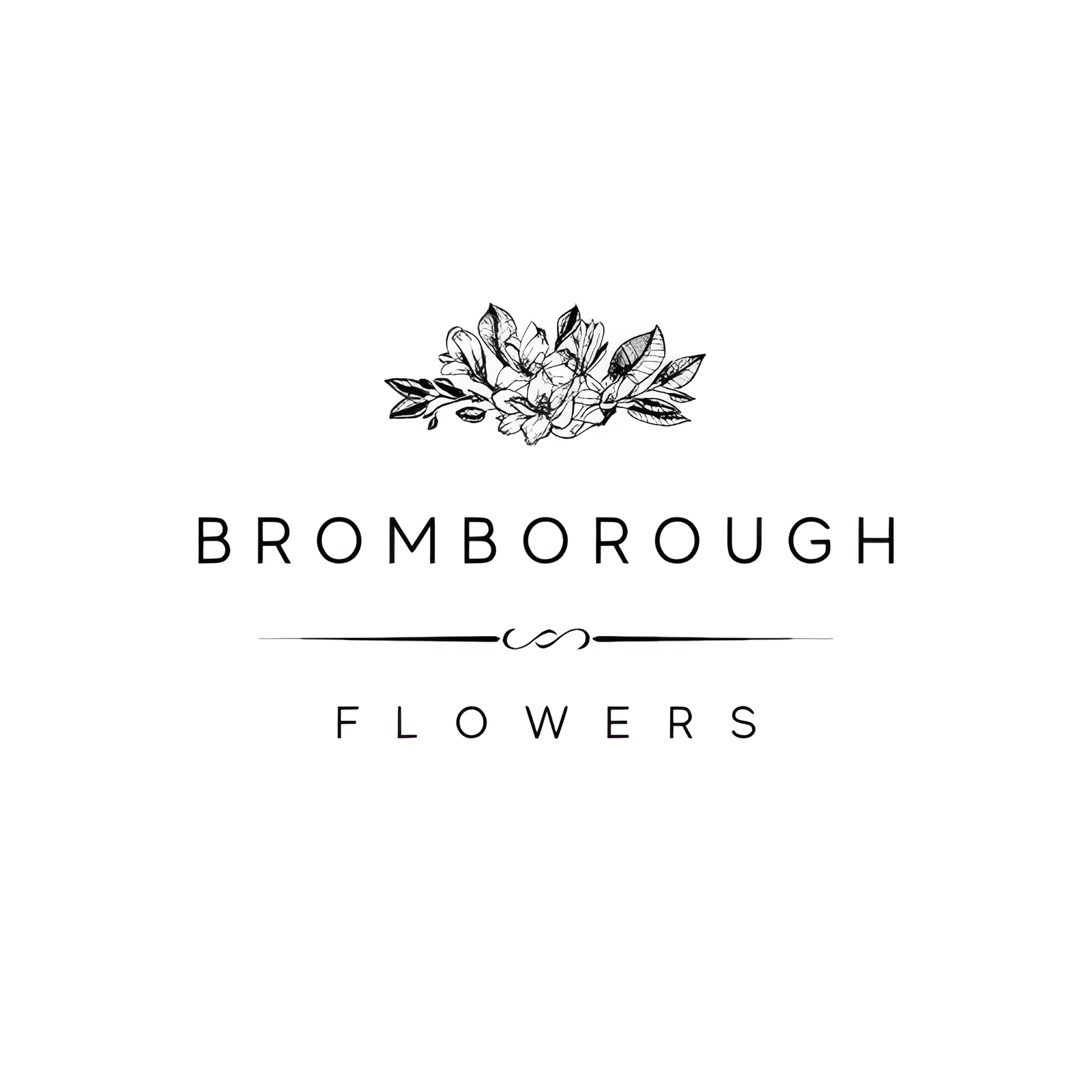Tulips, with their smooth stems and velvety petals, are a quintessential choice for wedding floral arrangements, exuding a timeless elegance that few other flowers can match. Their versatility and vibrant color palette, ranging from soft pastels to strikingly bold hues, make them suitable for a variety of wedding themes and styles. Originating from Central Asia and famously cultivated in the Netherlands, tulips are available all year round, symbolizing deep love and new beginnings. To understand how tulips can elevate your wedding decor and the rich cultural significance they carry, one must explore their diverse applications and symbolic meanings.
Flower Overview
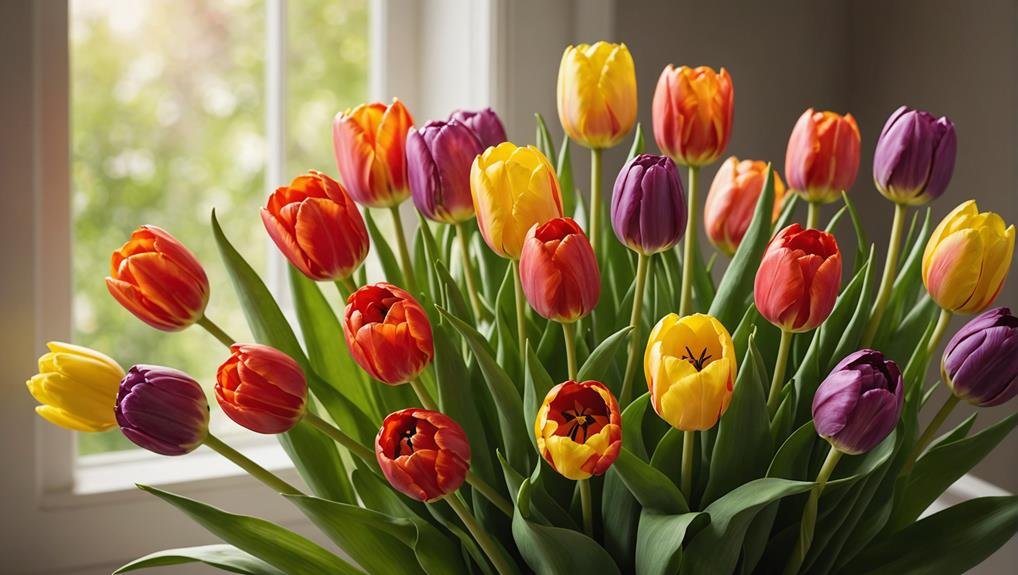
Tulips, known for their versatility and year-round availability, are a popular choice for diverse floral arrangements. In the context of weddings, tulips offer a myriad of possibilities for creating stunning and memorable bouquets. Their wide range of colors, from pastel pinks and vibrant yellows to deep reds and purples, makes them an ideal choice for any wedding theme and season.
For a Spring wedding, tulips can be skillfully integrated into floral designs, adding a fresh and elegant touch to bridal bouquets and centerpieces. They pair beautifully with flowers such as hydrangeas, roses, lisianthus, and stock, creating harmonious and visually appealing arrangements. The selection of tulip colors can be tailored to match the wedding palette, ensuring a cohesive and aesthetically pleasing look.
Furthermore, tulips are not limited to spring; their availability throughout the year means they can feature prominently in weddings during any season. Whether it’s a summer celebration with bright, cheerful hues or a winter wedding with classic red and white tulips, these flowers adapt well to various floral designs. Their versatility and timeless beauty make tulips a favorite among florists and brides alike for creating unforgettable wedding bouquets.
Physical Description
Known for their smooth, elongated stems and velvety, delicately layered petals, tulips present a visually stunning appearance in any floral arrangement. These flowers possess a distinctive silhouette that exudes grace and elegance, making them a popular choice for wedding bouquets and decor. The graceful stems of tulips, coupled with their vibrant colors, enhance their timeless beauty and appeal.
Tulips are admired for their unique petal structure, which creates a symmetrical and harmonious look. The petals, often described as velvety, come in a wide array of breathtaking colors. This extensive palette of tulip colors allows for versatility in floral designs, catering to various wedding themes and color schemes. The simplicity and symmetry of tulips contribute significantly to their enduring popularity in wedding arrangements.
With over 100 colors available, tulips offer a plethora of options to suit different wedding palettes. Each color of tulip can evoke a different mood or aesthetic, providing endless possibilities for customization. The combination of their smooth, graceful stems and vibrant hues makes tulips a unique and captivating choice among flower types, ensuring they stand out in any setting.
Available Colour Varieties

Intriguingly, the extensive palette of tulip colors offers a remarkable array of options for creating stunning and personalized wedding floral arrangements. From the classic elegance of white tulips to the deep allure of purple tulips, brides have a myriad of choices to suit their unique tastes and wedding themes.
White tulips, symbolizing purity and new beginnings, are a favored choice for traditional ceremonies, while vibrant red tulips, often associated with deep love and passion, make a bold statement. Pink tulips, with their gentle and romantic hue, lend a soft and delicate touch to bridal bouquets and centerpieces.
For those looking to incorporate a more eclectic or vibrant color scheme, colorful tulips in shades of yellow, orange, and various striking bi-color or striped varieties offer endless possibilities. The versatility of tulip colors guarantees that they can seamlessly blend into any wedding theme, whether it is classic, modern, rustic, or whimsical.
The availability of such a broad spectrum of vibrant colors allows brides to create personalized and meaningful floral designs that mirror their own style and the sentiment of their special day. This flexibility makes tulips an exceptional choice for wedding flowers.
Latin Name and Taxonomy
Understanding the Latin name and taxonomy of tulips provides valuable insights into selecting the right varieties for wedding arrangements. The tulip, bearing the Latin name Tulipa, belongs to the Liliaceae family. This classification is pivotal for distinguishing the plant’s unique features and understanding its diverse range. Under the genus Tulipa, tulips encompass over 75 wild species, showcasing an impressive array of characteristics and color variations.
The taxonomy of tulips is meticulously categorized into various divisions, each offering distinct qualities that can enhance wedding décor. These divisions include Single Early, Triumph, Darwin Hybrid, and Parrot tulips, among others. Single Early tulips are known for their robust, simple blooms, while Triumph tulips blend elegance with durability, making them ideal for bouquets. Darwin Hybrid tulips are celebrated for their tall stature and vibrant hues, and Parrot tulips stand out with their frilled, dramatic petals.
Understanding these divisions helps florists and brides-to-be select the most fitting tulip varieties, ensuring that the floral arrangements align with the desired aesthetic and theme of the wedding. By appreciating the Latin name and taxonomy, one can make informed decisions to create memorable and visually stunning wedding displays.
Geographical Origins
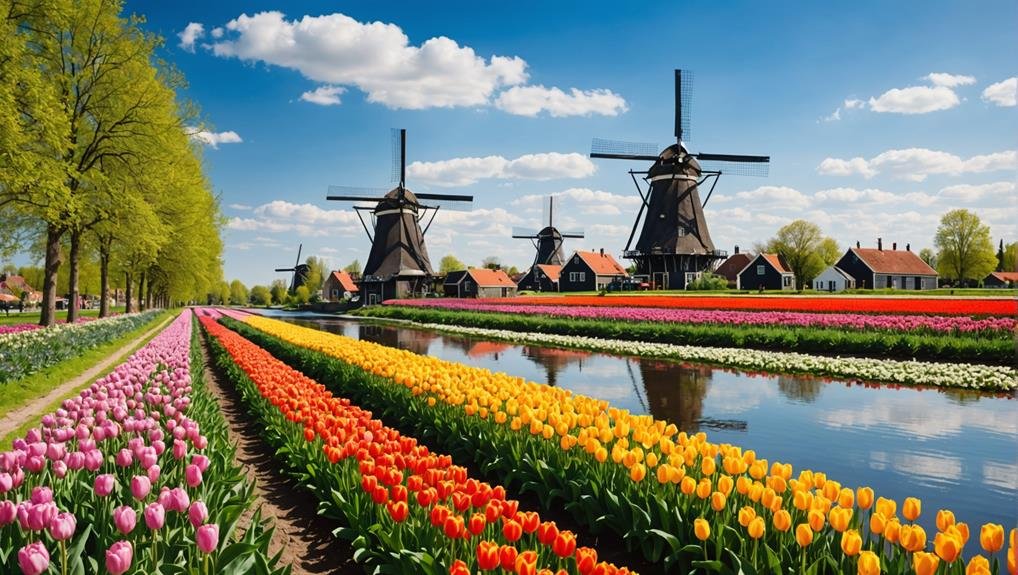
Originating in Central Asia, tulips were first cultivated by the Ottoman Empire in the 16th century. This early cultivation played a pivotal role in the flower’s journey across the globe. The Ottomans’ deep appreciation for the tulip’s beauty and versatility led to extensive cultivation practices that soon spread beyond their borders.
The Netherlands became synonymous with tulips in the 17th century, largely due to the phenomenon known as ‘Tulip Mania.’ During this period, tulips became a symbol of wealth and status, leading to an unprecedented economic bubble where bulb prices soared to extraordinary levels. This historical episode cemented the tulip’s association with Dutch culture and horticulture, making the Netherlands a global hub for tulip cultivation.
Tulips are now grown in various regions worldwide, including Turkey, the United States, and China. Each region’s specific climates and soil conditions contribute significantly to the variety and quality of tulips produced. The adaptability of tulips to different environmental factors has facilitated their widespread cultivation, making them a beloved choice for weddings and other special occasions.
Season Availability
The constant availability of tulips enhances their appeal for wedding floral arrangements, offering unparalleled flexibility and variety. This persistent availability guarantees that brides and planners can incorporate tulips into weddings regardless of the season, making them a versatile choice for any event.
Tulips are particularly abundant during the spring season, presenting a wide array of vibrant colors that can complement various wedding themes. Different types of tulips, such as parrot tulips and fringed tulips, add unique textures and visual interest to floral arrangements. These varieties are accessible throughout the year, allowing for a dynamic selection that suits both contemporary and traditional styles.
Seasonal colors play a significant role in choosing tulips for weddings. For example, red and white tulips are perfect for winter holidays, while yellow and orange tulips are ideal for fall displays. The perpetual availability of tulips means that they can be seamlessly integrated into wedding plans, whether the event is in the blooming spring or the frosty winter.
This flexibility, combined with the vibrant color options and unique types like parrot and fringed tulips, makes tulips a timeless choice for wedding floral arrangements.
Growing Conditions
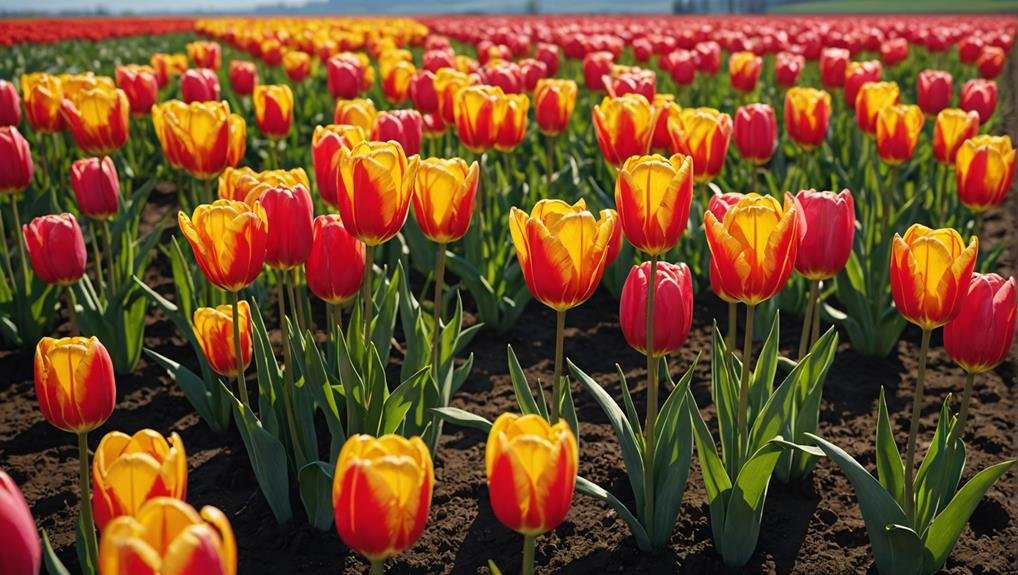
While the year-round availability of tulips makes them a versatile choice for weddings, their successful cultivation depends on specific growing conditions that guarantee vibrant blooms. Tulips thrive in well-drained soil, making sure that excess water does not lead to root rot. Ideal soil conditions include a pH level ranging from 6.0 to 7.0, which provides a balanced environment for nutrient uptake.
Full sun exposure is another crucial factor for tulip growth. These flowers require at least six hours of direct sunlight daily to develop strong, healthy blooms. Additionally, tulips require a chilling period, typically ranging from 12 to 16 weeks at temperatures between 35°F and 48°F (1.7°C to 8.8°C). This period is essential for breaking the dormancy of the bulbs and encouraging robust spring flowering.
Tulip bulbs should be planted in the fall, approximately six to eight weeks before the first hard frost. This timing allows them to establish roots before winter sets in. Adequate spacing between bulbs, generally about 4 to 6 inches apart, is essential to prevent overcrowding, which can impede growth and reduce the quality of the blooms.
Following these growing conditions will help tulips flourish, adding a touch of sophistication to any wedding setting.
Cultural Significance
Tulips often carry deep cultural significance in various countries, symbolizing themes such as love, prosperity, and beauty. In the Netherlands, tulips have been a symbol of love since the 17th century, when they became highly prized during the period known as ‘Tulip Mania.’ The vibrant and diverse colors of tulips make them a popular choice for expressing deep affection and passion.
In Turkish culture, tulips are associated with prosperity and beauty, often appearing in celebrations and ceremonies. The tulip’s elegant form and rich hues have made it a symbol of grace and good fortune. Historically, these flowers were cherished by Ottoman sultans and were prominently featured in art and decoration.
In Iran, tulips represent life, love, and rebirth. Different colors of tulips hold specific meanings, enhancing their cultural significance. Red tulips often symbolize deep love, while white tulips can signify purity and forgiveness. This intricate symbolism makes tulips a thoughtful choice for meaningful occasions.
Given their rich cultural heritage and versatile symbolism, tulips are an excellent option for Tulip Wedding Bouquets. Their ability to convey various themes of love and prosperity ensures they remain a timeless and culturally significant flower for weddings and celebrations worldwide.
Typical Use in Weddings
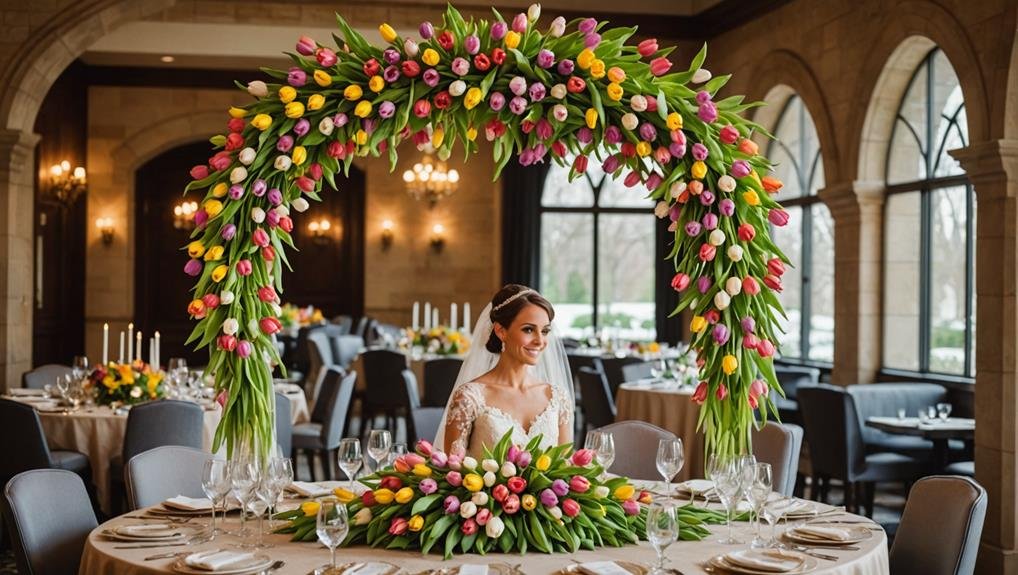
In wedding ceremonies, tulips frequently appear in bridal and bridesmaid bouquets, centerpieces, aisle decorations, and floral crowns. Their symbolism of deep love, new beginnings, and purity makes them ideal wedding flowers, adding both beauty and meaningful sentiment to the event. Tulips’ wide range of colors, shapes, and sizes offers flexibility, allowing them to seamlessly blend with various wedding themes and color palettes.
A typical bridal bouquet often requires 20-30 tulip stems, creating a lush and elegant arrangement. Bridesmaid bouquets tend to be slightly smaller, usually incorporating 15-20 stems. Tulips can also be arranged into cascading bridal bouquets, which provide a dramatic and flowing effect that enhances the bridal look. Floral crowns, adorned with tulips, add a whimsical and romantic touch, suitable for both brides and bridesmaids.
Centerpieces featuring tulips are a popular choice for wedding receptions, offering a sophisticated and vibrant decoration for tables. Additionally, tulips can be used in aisle decorations to frame the path to the altar, adding a cohesive floral element throughout the ceremony space. Their versatility and timeless elegance make tulips a favored choice for a wide range of wedding floral arrangements.
Alternative Flower Types
Numerous alternative flower types, such as roses, peonies, and hydrangeas, offer stunning options for wedding arrangements when tulips are unavailable. Roses, with their timeless elegance, can easily replace tulips, adding a romantic touch to any bouquet.
Similarly, peonies, known for their lush and full blooms, can create a visually striking centerpiece. Hydrangeas, with their voluminous clusters of flowers, provide a lush, garden-like feel to wedding decor.
For those seeking a more casual and whimsical look, daisies serve as an excellent swap. Their simple beauty and cheerful appearance can add a touch of innocence and charm. Lilies, available in a variety of colors and sizes, bring an air of sophistication and grace to wedding arrangements.
Sunflowers, with their bold and bright demeanor, can infuse a rustic and vibrant vibe into the celebration. Other popular replacements include orchids and carnations, both of which offer versatility in style and color.
Dahlias, calla lilies, anemones, and freesias also present diverse options, allowing for creative and personalized floral designs. Consulting with a professional florist can help make sure that the chosen alternative flowers align with the wedding’s color scheme and style preferences.
